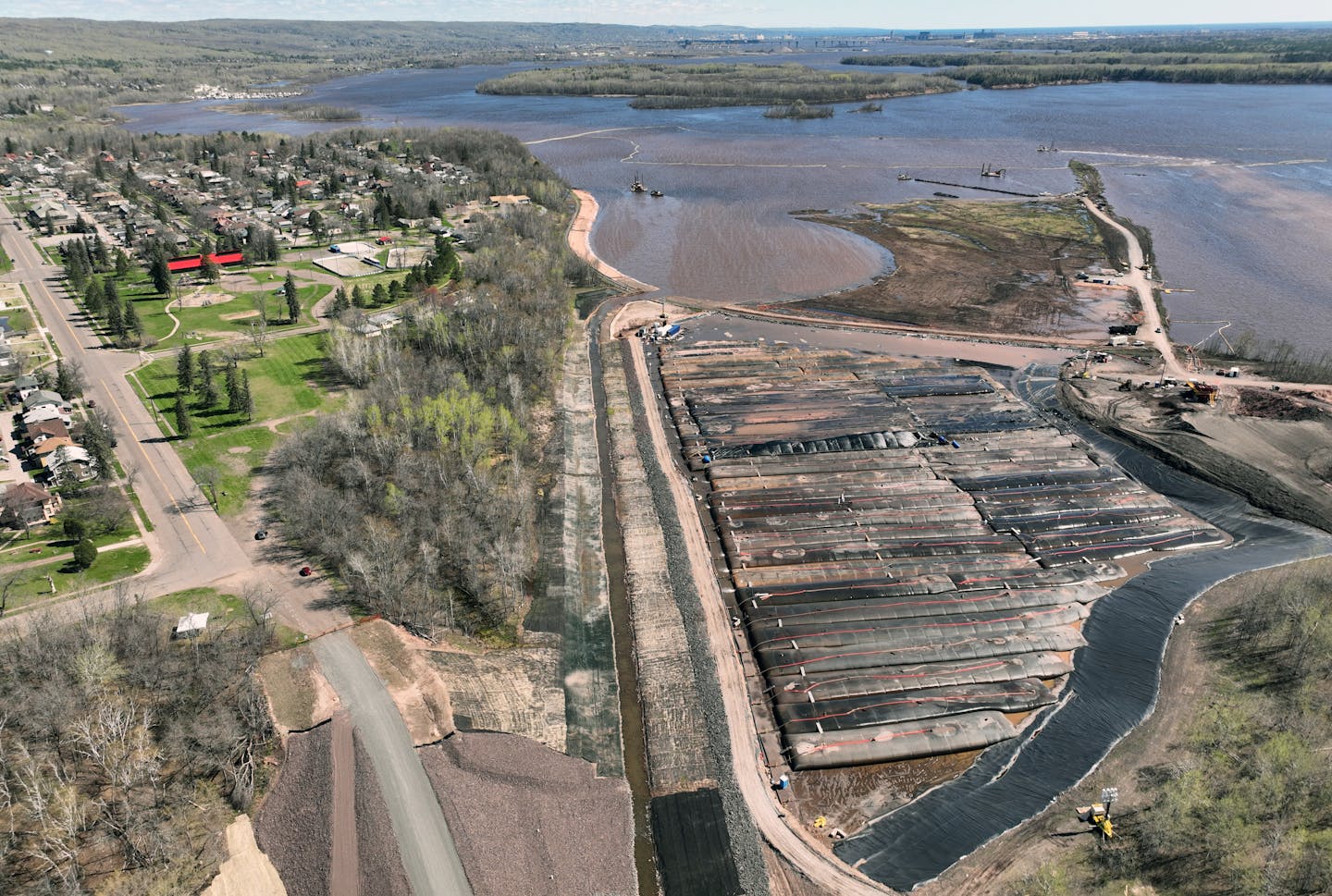DULUTH - Lloyd Hautajarvi knew of the poisons stewing in the St. Louis River in 1968.
Filled for a century with human waste and toxic chemicals, including those from the nearby U.S. Steel Duluth Works, the river was largely forbidden as a place to swim for the kids who grew up in Morgan Park back then. But one sweltering day he and a friend rolled their canoe just for a minute in the river's shallow muck. The next day, both had water blisters.
"That would keep you from too many swimming adventures," he said recently. "We knew what was in that river."
Federal, state, local and tribal efforts to clean up the St. Louis River, which separates Minnesota and Wisconsin, and remove it from a national list of polluted waterways have been ongoing for more than three decades. Now a major infusion largely from the federal infrastructure bill announced Tuesday in Duluth is expected to fast-track those efforts.
At the U.S. Steel Superfund site in Morgan Park, Environmental Protection Agency officials announced $113 million for three highly contaminated sites in the St. Louis River, paying for a major chunk of the work necessary to remove its federal Area of Concern (AOC) designation.
"This is an exciting day for everyone who loves the St. Louis River," said Debra Shore, leader of the EPA's Midwestern office. "Thanks to the bipartisan infrastructure law and the support from our private and state partners, we are on track to finish cleanup and restoration in the St. Louis River Area of Concern by the end of this decade ... and maybe as early as 2027."
About $100 million in work will remain to remove the river from the list of polluted sites it joined in 1987 under the U.S.-Canada Great Lakes Water Quality Agreement. With damage spanning from Cloquet to the Duluth-Superior Harbor, the river and its estuary were among the largest of the 43 listed sites.
So far, more than $237 million has been invested in cleanup. The new funding adds $81 million to complete the U.S. Steel-Spirit Lake project, $25 million for restoration of nearby Munger Landing and nearly $7 million for the Scanlon Reservoir.
"This money can really transform how people connect to the land," said Duluth Mayor Emily Larson.
'Just the beginning'
The St. Louis River spans the ancestral lands of the Fond du Lac Band of Lake Superior Chippewa. Long a haven for migratory birds and spawning grounds for lake sturgeon and other fish, it was designated a National Water Trail in 2020, with 11 loop trails for watercraft. The designation represents a major victory in the decades-long cleanup effort and is part of Duluth's vision for the western waterfront, as it improves parks and habitat and builds new trails and water access.
"The river is a huge part of our heritage," Larson said. "Generations of families have been impacted by development and industry along the river and we want future generations of families impacted by its natural setting and ecosystem and biodiversity."
Newcomers to the city, often drawn by the craft beer made possible by a cleaner estuary, largely don't know the river's history, said Kris Eilers, executive director of the St. Louis River Alliance, a local nonprofit long involved in river cleanup.
It's important to connect with them, creating more stewards for the waterway as it continues to heal, she said.
For those who manage its health, said Melissa Sjolund of the Department of Natural Resources, delisting will be just "the beginning."
"We get funding every year for this and get asked when we will be done," she said. "The answer is, we won't. ... Protecting these areas is going to be really important."
'People didn't understand'
When the Duluth Harbor canal opened in 1871, it made way for rapid expansion, with ships traveling up the St. Louis River from Lake Superior. Piers for heavy industry filled in wetlands. And everyone dumped just about everything into the river for 100 years, before wastewater treatment and other regulations existed.
"They thought the stream would take care of it" and dilute waste, said Barbara Huberty, who coordinates St. Louis River AOC work for the Minnesota Pollution Control Agency (MPCA). "People didn't understand the long-term effects."
It didn't take long for sewage and industry waste to suck the oxygen from the river, with poor water quality recorded in the early 1900s. Eventually, fish weren't able to penetrate the "biological barrier" to travel upstream to spawn, said Joel Hoffman, a Duluth-based EPA research biologist.
"For roughly 50 years, this river went dead year after year after year," he said.
When Duluth's first major wastewater treatment plant opened in 1978 — Western Lake Superior Sanitary District — it was "a huge turning point," Hoffman said. "Oxygen, and therefore life, came roaring back to the river."
Dennis Doherty, who grew up in and continues to live in the city's Riverside neighborhood, recalls when that happened. "The river immediately had a different look to it," he said.
But toxic pollutants — including mercury and others that can cause cancer and breathing problems — remained in the river, threatening humans and wildlife.
Complex sites
Removal from the federal list requires eliminating "impairments," of which the St. Louis River originally had nine. Six remain, with one under consideration for removal this spring. About a dozen projects are under way or awaiting funding. Most involve dredging or restoration, and they range from slips in the harbor to the Scanlon Reservoir where power was produced, more than 20 miles south of Duluth.
Started in 2020, the largest and most complex contamination removal project involves Spirit Lake, the section of river next to the U.S. Steel site, a coking and mill operation that closed in 1981. Total remediation costs are $165 million, of which U.S. Steel is paying 51%.
In all, more than 1.3 million cubic yards of toxic river bottom are being dredged, sifted and stored in special containers on site, or safely capped. Nearly 120 acres in the river will be covered with clean sand and a new 42-acre shallow sheltered bay for spawning grounds will be built.
Another complex project was completed last fall at Grassy Point, once the site of two sawmills built over the water that left scraps stacked up 16 feet deep across 75 acres, choking out life.
The DNR project used the healthy but excess dirt from nearby Kingsbury Bay to line the bottom of Grassy Point. And the removed clean wood was repurposed to build an island that shields the bay behind it, protecting it from wind and waves, said Guy Partch of Barr Engineering, which was tasked with carrying out the work.
Now it's the type of sheltered bay "very prized" in the estuary, Partch said.
Tuesday's milestone, and others like the water trail designation, will attract more people to a river worthy of being a destination, said the MPCA's Huberty.
The trail is an example of what it's becoming, showing a "wild" side that many who've lived here for decades don't know exists, she said.
"You get in there and you feel like you're in the Boundary Waters, and you're only [a few] miles from home," Huberty said. "What people have been dreaming about for decades is finally coming to fruition."






![Kathy Cargill's home in Duluth's Park Point neighborhood. Cargill's limited liability company has purchased more than 20 parcels on the point. ] JANA](https://arc.stimg.co/startribunemedia/BTNQVSCQD5GQLP6YRUSBSH6FQM.jpg?w=75&h=75&fit=crop&crop=faces)



